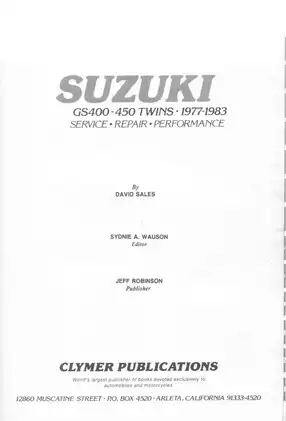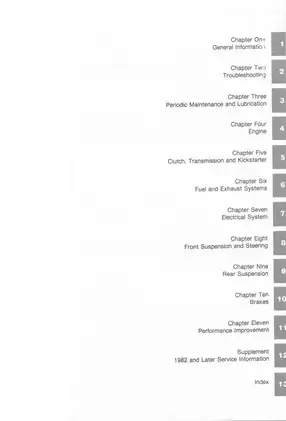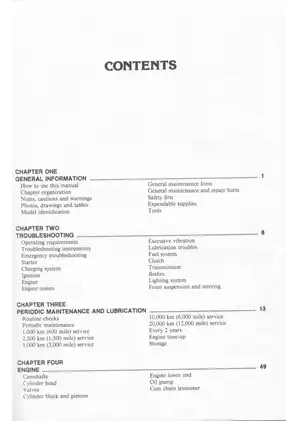Factory Grade Suzuki GS400/GS450 Twins manual ´77-83
Product Gallery

Sample pages from the Factory Grade Suzuki GS400/GS450 Twins manual ´77-83 manual



Purchase Information
1977-1983 Suzuki GS400, GS450 Twins service repair manual - Technical Specifications
- Document Number / Seller:
- 29779 / Margaret Bell
- File Size:
- 194.68 MB
- File Type:
- ZIP
- Language:
- English
- Printable:
- Yes
- Estimated Download Time:
- 3.99 Minutes
- Delivery Format:
- Digital (PDF) - Instant Access
- Category:
- Bike
- Brand:
- Suzuki
- Reviewed and Approved:
- Oct 9, 2025
Suzuki Models and Parts Covered in this Bike Manual
1977-1983 Suzuki GS400, GS450 Twins
- GS400
- GS450
Complete Manual Information
Table of Contents
General Information
- How to Use this Manual
- Model Identification
- Machine Orientation
- Data, Dimensions, and Specifications
- General Maintenance Hints
- Supplies
- Tools
Troubleshooting
- Troubleshooting
- Engine Starting
- Ignition System
- Fuel System
- Charging System
- Engine Systems
- Drive System
- Suspension and Steering
Periodic Maintenance and Lubrication
- Maintenance Schedules
- 1,000 km (600 mile) Service
- 5,000 km (3,000 mile) Service
- 10,000 km (6,000 mile) Service
- 20,000 km (12,000 mile) Service
- Lubrication
- Oils
- Greases
- Storage
Engine
- Engine Removal
- Engine Disassembly
- Cylinder Head
- Cylinder Block and Pistons
- Crankshaft
- Engine Reassembly
- Piston Rings
- Cylinder Head
- Timing Chain
Clutch, Transmission, and Kickstarter
- Clutch
- Transmission
- Kickstarter
Fuel and Exhaust Systems
- Fuel System
- Carburetor
- Fuel Tank
- Exhaust System
- Muffler
- Exhaust Pipes
Electrical System
- Battery
- Charging System
- Ignition System
- Lights
- Switches
- Wiring Diagram
Front Suspension and Steering
- Front Fork
- Steering Stem
- Wheel and Tire
- Brakes
Rear Suspension
- Rear Shock Absorber
- Swing Arm
- Wheel and Tire
- Brakes
Brakes
- Brake System
- Front Brake
- Rear Brake
- Brake Adjustment
- Brake Pads and Shoes
Performance Improvement
- Engine Tuning
- Carburetor Adjustment
- Exhaust System Modification
- Suspension Adjustment
Supplement
- 1982 and Later Service Information
Index
- Index
Download Instructions for Suzuki Bike Manual
Frequently Asked Questions - Suzuki Bike Manual
What does this Suzuki manual cover?
This comprehensive service manual covers detailed repair procedures, maintenance schedules, troubleshooting guides, and technical specifications for Factory Grade Suzuki GS400/GS450 Twins manual ´77-83. It includes information for the following models: **1977-1983 Suzuki GS400, GS450 Twins** > - GS400 > - GS450 .
Is this manual suitable for beginners?
Yes, this Suzuki manual is designed for both professional technicians and DIY enthusiasts. It includes step-by-step procedures with clear illustrations and safety guidelines for Bike maintenance and repair.
What file format will I receive?
You will receive this manual as a ZIP file (194.68 MB), which is compatible with all devices. The manual is fully searchable and printable for your convenience.
How quickly can I access the manual after purchase?
You'll receive instant access to your Suzuki Bike manual immediately after payment completion. The download link is valid for 3 days, with lifetime re-download guarantee.
Can I print specific sections of the manual?
Absolutely! This digital manual allows you to print any section you need, from individual pages to complete chapters, making it perfect for workshop use.
Customer Reviews and Feedback
Read what our customers say about this Suzuki Bike manual and share your own experience.
Add Comment
This policy contains information about your privacy. By posting, you are declaring that you understand this policy:
- Your name, rating, website address, town, country, state and comment will be publicly displayed if entered.
- Aside from the data entered into these form fields, other stored data about your comment will include:
- Your IP address (not displayed)
- The time/date of your submission (displayed)
- Your email address will not be shared. It is collected for only two reasons:
- Administrative purposes, should a need to contact you arise.
- To inform you of new comments, should you subscribe to receive notifications.
- A cookie may be set on your computer. This is used to remember your inputs. It will expire by itself.
This policy is subject to change at any time and without notice.
These terms and conditions contain rules about posting comments. By submitting a comment, you are declaring that you agree with these rules:
- Although the administrator will attempt to moderate comments, it is impossible for every comment to have been moderated at any given time.
- You acknowledge that all comments express the views and opinions of the original author and not those of the administrator.
- You agree not to post any material which is knowingly false, obscene, hateful, threatening, harassing or invasive of a person's privacy.
- The administrator has the right to edit, move or remove any comment for any reason and without notice.
Failure to comply with these rules may result in being banned from submitting further comments.
These terms and conditions are subject to change at any time and without notice.
Comments (1)